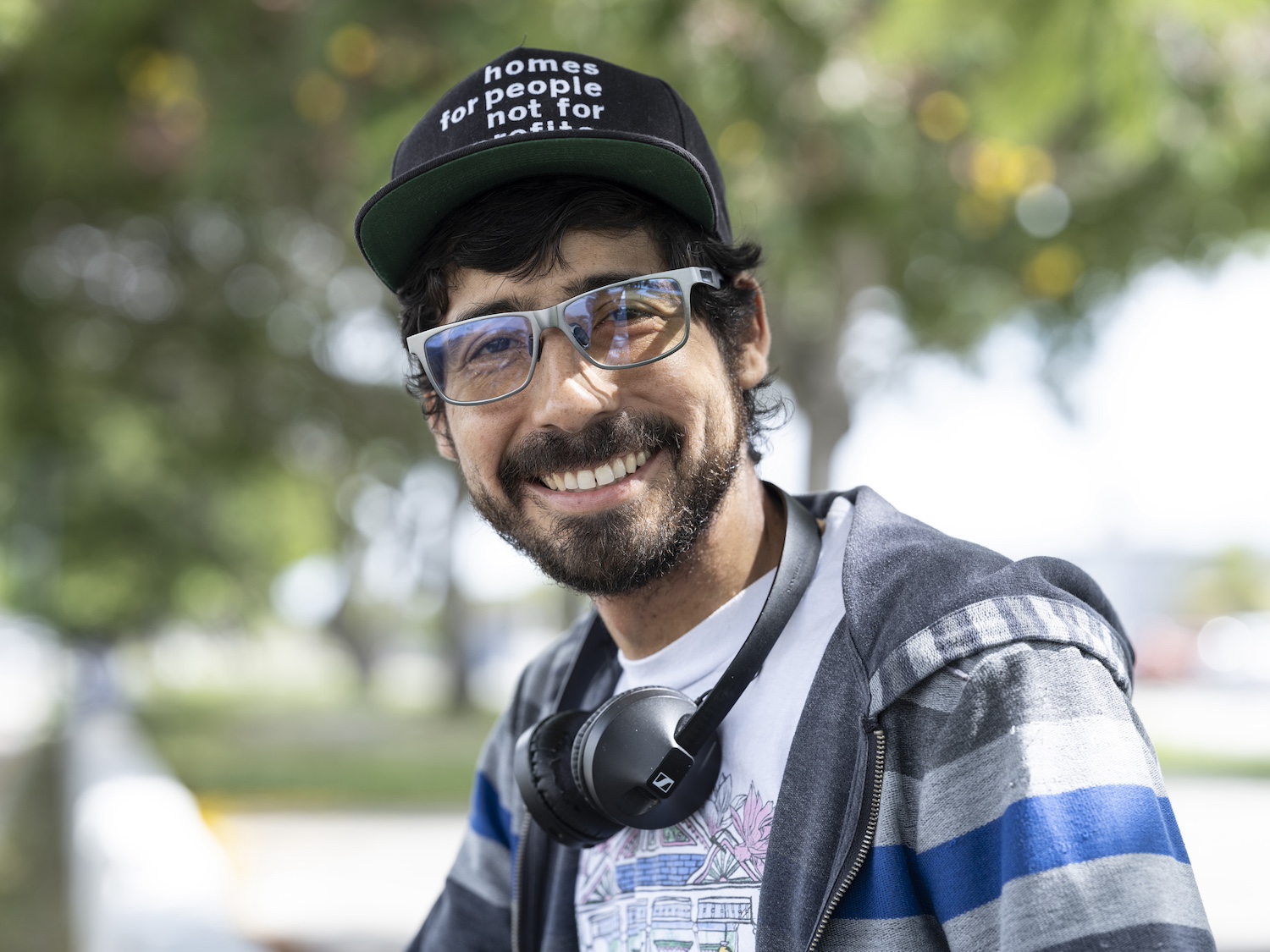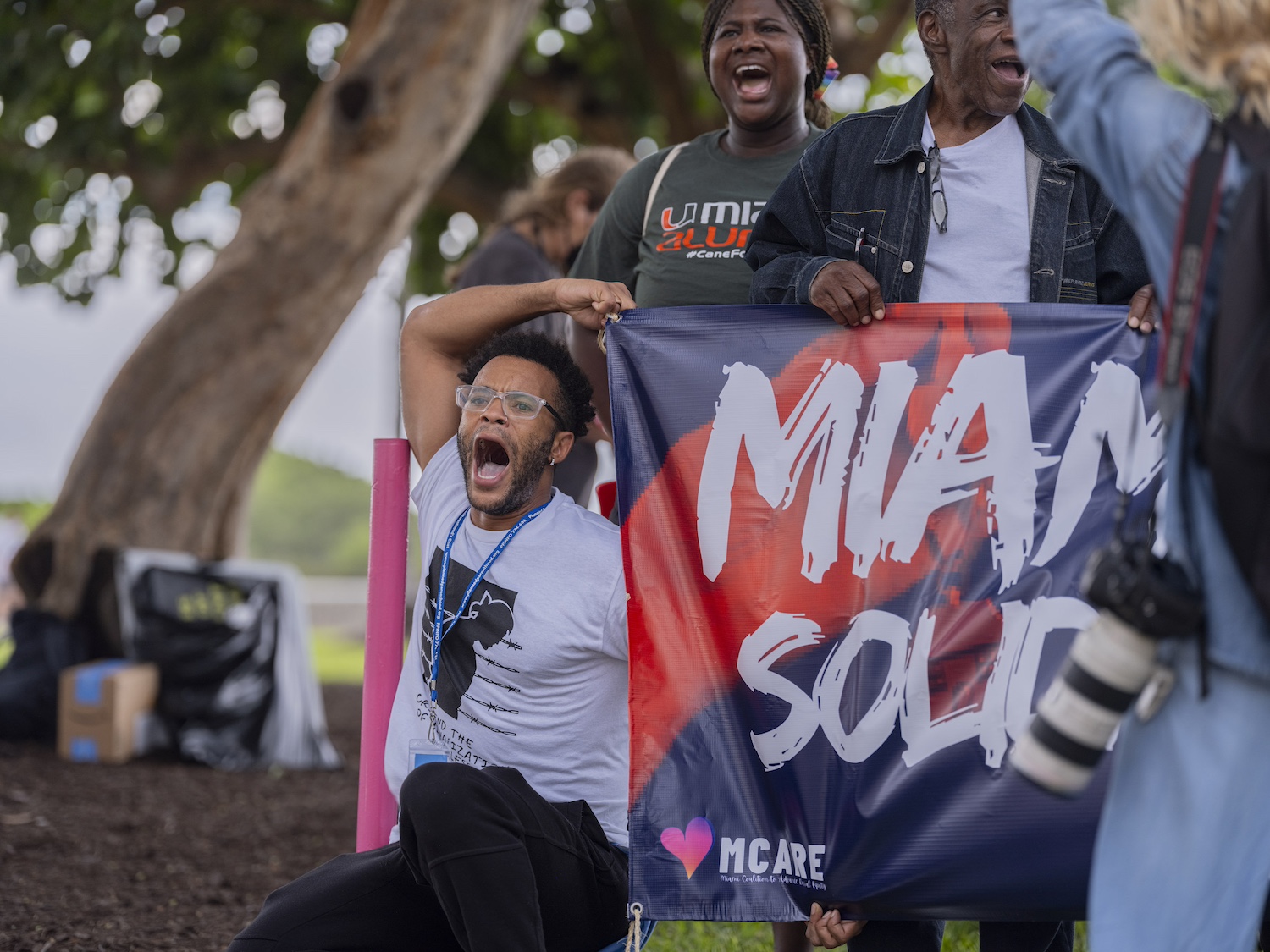
The Struggle for Miami’s Affordable and Sustainable Housing (SMASH) team prepares to organize in Miami, Florida. (Image: Nina Robinson)
At the end of 2024, Dream.Org launched the Make It Real photojournalism series to highlight the challenges and triumphs of those fighting for a more sustainable and equitable future. We're collaborating on a series of TriplePundit articles to share the stories of the people and communities on the frontlines of climate equity in the United States.
Residents of Miami’s low-income, high-elevation communities are faced with a growing phenomenon: climate gentrification. It’s a problem the nonprofit Struggle for Miami’s Affordable and Sustainable Housing (SMASH) is working to solve through its community land trust model. “We believe that the best way to mitigate it is to put those lands into the community's control,” Adrian Madriz, the organization’s co-founder, told TriplePundit.
SMASH started in 2015 with its Smash the Slumlords campaign. It organized community members to fight back against landlords who failed to maintain the health and safety of their properties, allowing vermin and mold to proliferate while ignoring needed repairs. The experience inspired the organization’s evolution into a community land trust — a nonprofit model that involves owning land on behalf of a community to ensure affordable housing for those who live there and spur community development projects.
“We realized that there was a real need for an organization that would be in a position to actually take control of these properties,” Madriz said. “Because what would happen after we got rid of a slumlord in many of these situations, is the city would take receivership of the property, and then they would just sell it to another developer.”
From there, the developers improved the properties, but they also increased the rent beyond what the original tenants could pay, leaving them homeless, he said.

Climate gentrification threatens low-income neighborhoods
It’s not just deteriorating properties that developers are gobbling up, they’re also after family homes in those same high-elevation Miami neighborhoods — Liberty City, Overtown, Little Haiti and Little Havana. Many of these homes were owned by the same families for upwards of five generations, Madriz said. Since they’re on higher ground, the land is more attractive to developers and wealthy Floridians seeking to escape the effects of climate change felt more acutely at sea level, like increased flooding. This is one of many ways climate gentrification manifests.
“Insurance companies are raising their rates on properties in coastal areas because they're not dumb. They know climate change is real, and they know that in a matter of a few years, maybe about 10, the property they have on the water could be in the water,” Madriz said. “And developers, they care about their bottom line. They don't want to develop on the coast anymore because it's becoming so expensive with the insurance. They want to develop in areas that are going to be cheaper, and that happens to be these low-income, high-elevation areas.”
High eviction rates and resident transitions have increased dramatically since Hurricane Irma flooded southern Florida — proof that climate gentrification is forcing people out faster, Madriz said.
He pointed to the historically Black neighborhood of West Grove, a community steeped in Black culture and history with a legacy of birthing star athletes, as an example. “You can't find hardly any Black homeowners in the Grove,” Madriz said. But you will find plenty of malls and condo towers.
“The thing that makes it so terrible is when those developers were trying to build those properties, they had to accumulate parcels to have enough acreage to be able to do some of those larger projects,” he said. “So they would go door-to-door in neighborhoods like the West Grove and offer these homeowners what was supposedly the deal of the century: $90,000 for your four-bedroom, three-bath that's like a minute from downtown.”
For many cash-strapped homeowners facing repairs on aging properties, it sounded like a good deal, Madriz said. Instead of sinking more funds into their current home, many took the offer under the guise that it would be simple to use it as a down payment for something better elsewhere.
Affordable housing as a strategy for organizing
As a community land trust, SMASH is fighting climate gentrification through community property control. Its board is made up of residents from its properties as well as people from the community and area professionals, Madriz said. Together, they make development and maintenance decisions to ensure the land is responsibly and sustainably managed.
Available housing on the property also serves as a space for community organizers to stay while doing outreach and hosting workshops and events.
“Before we had the [housing program], it was very difficult to ask people to engage in that work and commit to it over the long term because they would constantly move around,” Madriz said.
Mutual aid through affordable housing has proven to be SMASH’s most effective strategy, he said. Thanks to stable housing, organizers can focus on training and implement consistent activism instead of battling their landlords.
The program, called the Housing and Healing Justice Cooperative, is currently home to nine residents aged nine to 72, hosting three businesses and meetings with up to 70 attendees. The residents spend at least four hours per week organizing for housing justice through phone calls, door knocking and reaching out to others in the community. Their work enabled SMASH to grow to 270 members fighting for housing justice and collect 1,500 signatures on its petition to make housing a human right in Miami, Madriz said.

The nonprofit is developing a second property in the same way, but this one will offer free housing to LGBTQ+ youth experiencing homelessness while they attend school or workforce training. The same volunteer stipulations will apply to those residents.
While these successes reflect well on the organization’s blueprint, they haven’t come without challenges. SMASH’s first attempt at purchasing and developing a property in 2018 didn’t go as planned. The organization planned to build a duplex on a lot it purchased, but a change in county staffing resulted in old code violations not being waived as was previously promised, Madriz said.
“Unfortunately, those are the risks you take when you do these kinds of deals,” he said.
To expand its reach going forward, SMASH is developing a real estate investment trust based on the East Bay Permanent Real Estate Cooperative in California, which divides properties into shares split between residents and investors in the social impact space, Madriz said. For SMASH’s trust, the homeowner will receive a 51 percent share of the home. To purchase a $500,000 home, for example, the homeowner would pay $255,000 and the impact investors would cover the remainder.
“[The investors] can exchange their shares at will," Madriz said. "They can also get a return on their shares whenever they sell them, but the catch is they can never sell the actual home itself because the homeowner is always the one in control, and the home itself sits on our community land trust.”
This method will allow everyday people, instead of developers and investors seeking quick profits, to purchase homes in their community and build equity. It's all a part of the nonprofit’s mission to help people recognize the power they hold.

Riya Anne Polcastro is an author, photographer and adventurer based out of Baja California Sur, México. She enjoys writing just about anything, from gritty fiction to business and environmental issues. She is especially interested in how sustainability can be harnessed to encourage economic and environmental equity between the Global South and North. One day she hopes to travel the world with nothing but a backpack and her trusty laptop.














